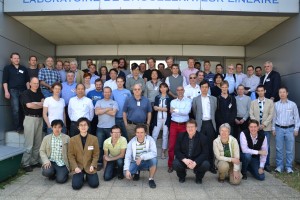The creation of a detector blueprint draws on diverse resources: physics cases, engineering choices, computational capacity and human drive. The Detailed Baseline Design Report (DBD) is slowly but steadily appearing on the horizon, and it will reflect the weaving together of these elements to present the best realistic manifestation of ILD.
After the Letters of Intent were completed in 2009, two detector concept groups, called ILD and SiD, were invited by the international advisory committee IDAG to move towards the DBDs. These documents will accompany the Technical Design Report (TDR) of the ILC machine. It is of paramount importance to restate the physics case for the ILC at energies up to 1 TeV, which will be worked out by the community and presented in a separate document.
The ILD concept group met in May in Paris at LAL for the fifth dedicated ILD meeting to discuss the state of the work on the ILD concept and to plan the next steps. This meeting originally was planned to take place at KEK in Japan, but due to the serious earthquake and its consequences it was decided to move it on short notice to LAL.
The detector baseline document should describe the ILD concept in detail and should contain more realism in its description and planning than previous documents. Both the description of the hardware and the anticipated performance of the detector should be based on serious studies and results rather than estimates with unrealistic assumptions.
One of the main aims of the workshop was the definition of a so-called simulation baseline to be used for the mass simulation of events. This baseline is a compromise between a certain level of detail and simplifications necessary for modelling the detector. It must nevertheless maintain adequate performance and manageable simulation runs.
Speaking of realism, it is clear that a realistic detector model cannot be proposed without a tight collaboration between physicists and engineers; the role of the latter in the process cannot be overestimated. Much of the progress collaborators have made since the Letters of Intent was reported in the quest to move the physicists’ models to a serious engineering model with allowances for cables, supporting structures and a critical view that everything eventually fits together. On the other hand a careful control of these things has to happen to ensure that the physics goals are not compromised; this also necessitates similar realism in the detector model used for physics simulation.
It was refreshing to see how many new physics analyses were presented during the workshop, mostly based on fully simulated and reconstructed ILD events. These analyses are a perfect way for young students to get involved and to learn about the physics and the detector. All of the analyses cover the topics for which the concept groups have been asked by the advisory group to demonstrate for the DBD.
The DBD itself will present on equal footing options for sub-detectors for ILD. Detector components that at the time of the DBD will have demonstrated their feasibility and performance in test beams will be considered as an option. An option has to be distinguished from an alternative, which reflects a less advanced proposal of a technology. ILD will not make any technology decisions at this moment, but maintain a broad spectrum of options and alternatives. This key element of the ‘philosophy’ of the DBD has been emphasised in particular in the concluding remarks of ILD Joint Steering Board member Ties Behnke.
The workshop was a testament that the March catastrophe in Japan did not reduce the determination of our Japanese colleagues to pursue the work towards a linear collider in general and the ILD concept in particular. Apart from a strong participation by Japanese colleagues, this is maybe best underlined by the contribution of Akira Yamamoto, who summarised the ongoing efforts in Japan towards the siting of the machine in Japan.
Finally, did ILD succeed in defining a software baseline? Yes, although the definition of a baseline was slightly adapted. ILD decided that it would pursue an ambitious and active program to support in particular the two main hadronic calorimeter options, analogue and digital, on an equal footing and ensure that both options are adequately represented and simulated. This reflects the enormous work and progress that has taken place over the last years on both technologies, which enables ILD to seriously propose both as valid options.



Recent Comments